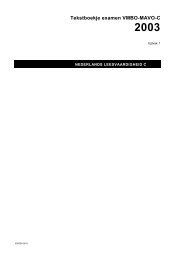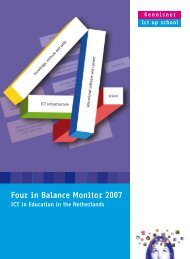Four in Balance Monitor 2011 - downloads.kennisn... - Kennisnet
Four in Balance Monitor 2011 - downloads.kennisn... - Kennisnet
Four in Balance Monitor 2011 - downloads.kennisn... - Kennisnet
Create successful ePaper yourself
Turn your PDF publications into a flip-book with our unique Google optimized e-Paper software.
2 - BENEFITS oF USING ICT<br />
The education sector has not concerned itself with this problem <strong>in</strong> any<br />
consistent manner. It is wrongly assumed that youngsters are so handy<br />
with computers that schools do not need to teach them how to search for<br />
and select <strong>in</strong>formation on the Internet. By way of illustration: a recent<br />
study has shown that only one out of five primary and secondary school<br />
teachers gives frequent or very frequent lessons on us<strong>in</strong>g Internet sources<br />
selectively (Van Gennip, <strong>2011</strong>a; <strong>2011</strong>b).<br />
That means that pupils’ digital literacy currently depends ma<strong>in</strong>ly on the<br />
situation at home and what their school happens to teach them. Unlike<br />
most of the other European Union Member States (Eurydice, <strong>2011</strong>), the<br />
Netherlands has not def<strong>in</strong>ed learn<strong>in</strong>g objectives for the digital skills that<br />
young people need to survive <strong>in</strong> the twenty-first century.<br />
Studies are mak<strong>in</strong>g it <strong>in</strong>creas<strong>in</strong>gly clear, however, that many pupils are<br />
<strong>in</strong>capable of us<strong>in</strong>g the Internet effectively as a learn<strong>in</strong>g resource (oECD,<br />
2010a; Walraven, <strong>2011</strong>). In other words, we tend to overestimate pupils’<br />
computer skills (Kanters, 2009). Although many pupils have mastered a<br />
number of ICT skills, that does not mean that they are capable of us<strong>in</strong>g ICT<br />
to learn or of us<strong>in</strong>g it responsibly, critically, and creatively.<br />
2.6 Learn<strong>in</strong>g to learn<br />
“Learn<strong>in</strong>g to learn” covers various teach<strong>in</strong>g methods that focus primarily<br />
on the pupil’s learn<strong>in</strong>g process and his or her awareness of that process.<br />
The content is subord<strong>in</strong>ate to the process. There is some overlap between<br />
learn<strong>in</strong>g to learn and <strong>in</strong>quiry-based learn<strong>in</strong>g.<br />
We still know too little about the added value of applications that support<br />
this type of learn<strong>in</strong>g. Schools are experiment<strong>in</strong>g with ICT <strong>in</strong> this respect,<br />
but the work<strong>in</strong>g methods are still too open-ended to study their effects.<br />
29








